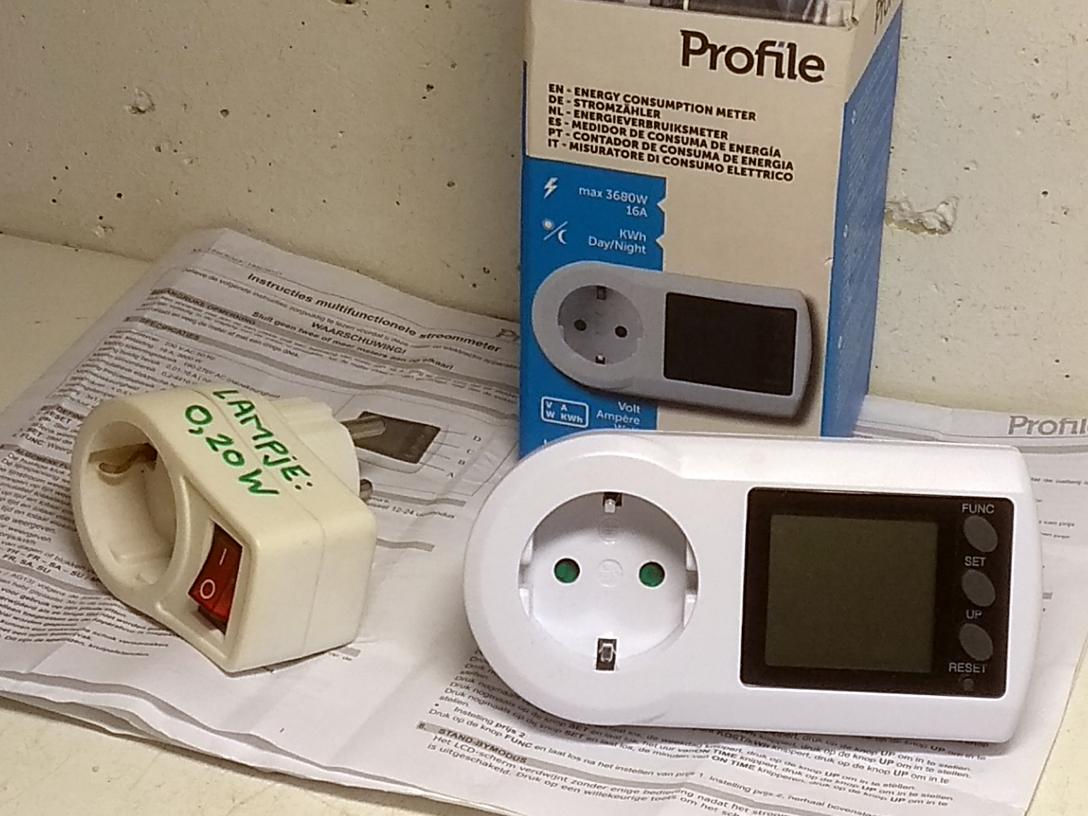Price was €13.99.
conductors
 CS5460A.
CS5460A.
572
Item nr.

Horizontal (very!) high precision Watt meter
| Production | Asia(?), 2022.
Price was €13.99. |
|---|---|
| Bands | Voltage, Current, Power, Consumption, Power factor. |
| Semi- conductors |  CS5460A. CS5460A. |
| Cabinet | Plastic. Size 12.5x6.5x3.5cm. |
| Power | AC 235V. |
| Documents | Instructions Part 1 and Part 2, power meter theory. |
 To my joy and surprise, this cheapest model from the Gamma store has centiWatt resolution. Like most similar energy monitors, it also shows voltage, current, accumulated consumption, and power factor. One can also enter energy prices for day and night separately, and show the cost. But this is a feature I don't need and use. For persistance of measurements and memory, it is possible to place three AG13/LR44 button cells.
To my joy and surprise, this cheapest model from the Gamma store has centiWatt resolution. Like most similar energy monitors, it also shows voltage, current, accumulated consumption, and power factor. One can also enter energy prices for day and night separately, and show the cost. But this is a feature I don't need and use. For persistance of measurements and memory, it is possible to place three AG13/LR44 button cells. Downsides of this nice meter are that it is hard to insert the batteries well, and also the reading is difficult under bad light conditions.
| Obtained | 9/2022 from Gamma store. |
|---|---|
| Condition | 9; replaced shunt. |
| Value (est.) | 10€. |
 0.01W, but the measurement threshold is 0.20W. So, below 0.20W the meter indicates 0.00W. Fortunately, it turned out that the power consumption of the little light in a socket switch switch is roughly 0.20 to 0.21W (probably most of this goes into a series resistor...). So I keep the switch with my meter in my lab, and measure small powers through the switch, and subtract 0.20W from the reading.
0.01W, but the measurement threshold is 0.20W. So, below 0.20W the meter indicates 0.00W. Fortunately, it turned out that the power consumption of the little light in a socket switch switch is roughly 0.20 to 0.21W (probably most of this goes into a series resistor...). So I keep the switch with my meter in my lab, and measure small powers through the switch, and subtract 0.20W from the reading. 
 The precision of the meter was increased tenfold by a replacement of the current measuring shunt. The original shunt is seen on the left, between the red wires. It is a rather thick piece of metal, providing a measurement resistance of a few milliOhms. It took me some effort to remove it. I tested my modification with a lamp consuming 4.6W. First I put a wire of 101mm over the shunt contacts and the meter indicated 26.1W. So I increased the length to 182mm and finetuned it to 190mm, and then the meter showed 46.03W, where my deciWatt-meter read 4.6W. Of course, the measuring steps of 0.1 are large related to the total power, and with a larger load, the meter can be callibrated more accurately. Using a 100W incandescent bulb, I tuned the shunt wire to a length of 203mm, and achieved a power reading within 1% of the deciWatt meter. So, the meter is now fit to measure (small) powers up to milliWatt resolution, with a measurement threshold of ca. 20mW. Note: this is very nice for small values, like the consumption of USB chargers and switching clocks, that are usually under the measuring threshold of 0.2W. For larger loads, like over several Watts, the extra digit is probably not very useful because of the inaccuracy introduced by my simple shunt.
The precision of the meter was increased tenfold by a replacement of the current measuring shunt. The original shunt is seen on the left, between the red wires. It is a rather thick piece of metal, providing a measurement resistance of a few milliOhms. It took me some effort to remove it. I tested my modification with a lamp consuming 4.6W. First I put a wire of 101mm over the shunt contacts and the meter indicated 26.1W. So I increased the length to 182mm and finetuned it to 190mm, and then the meter showed 46.03W, where my deciWatt-meter read 4.6W. Of course, the measuring steps of 0.1 are large related to the total power, and with a larger load, the meter can be callibrated more accurately. Using a 100W incandescent bulb, I tuned the shunt wire to a length of 203mm, and achieved a power reading within 1% of the deciWatt meter. So, the meter is now fit to measure (small) powers up to milliWatt resolution, with a measurement threshold of ca. 20mW. Note: this is very nice for small values, like the consumption of USB chargers and switching clocks, that are usually under the measuring threshold of 0.2W. For larger loads, like over several Watts, the extra digit is probably not very useful because of the inaccuracy introduced by my simple shunt.